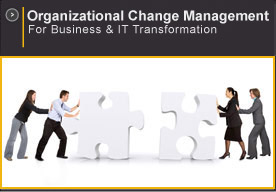OTA's OCM Methodology & Accelerators
 OTAís OCM methodology provides a proven and repeatable set of activities, deliverables and accelerators to plan, execute and
monitor OCM.
OTAís OCM methodology provides a proven and repeatable set of activities, deliverables and accelerators to plan, execute and
monitor OCM.
For an overview of the OTA OCM Methodology, click here
For a sample list of the OTA OCM Accelerators, click here
More information:
Organizational Change Management (OCM) methodology allows an organization to identify and mitigate risks and ensure value realization through the following elements:(Click on the element title to see a brief description)
Risk Management
One of the great challenges of change management is measurement, especially before the project is completed. How does one
know with reasonable certainty that communication or sponsorship interventions are truly effective? OTA's approach to
defining and monitoring the progress of change interventions revolves around effective risk identification and mitigation.
Risk identification is a function of experience, and one of the key reasons to engage external consultants is the knowledge they bring of the risks most likely to affect the project, and of the best ways to mitigate them. OTA's repository of project risks enables its consultants to identify, at each phase of the project, potential risks and the most cost effective way to prevent them from becoming issues or obstacles. It is important to stress that risks are dynamic in nature and must be monitored at the steering committee or program management level. OTA's experience in professional program and project management (see relevant OTA project seminars) make it possible to integrate organizational and human risk into an overall project risk register.
Risk identification is a function of experience, and one of the key reasons to engage external consultants is the knowledge they bring of the risks most likely to affect the project, and of the best ways to mitigate them. OTA's repository of project risks enables its consultants to identify, at each phase of the project, potential risks and the most cost effective way to prevent them from becoming issues or obstacles. It is important to stress that risks are dynamic in nature and must be monitored at the steering committee or program management level. OTA's experience in professional program and project management (see relevant OTA project seminars) make it possible to integrate organizational and human risk into an overall project risk register.
Risk management helps feed and monitor all project organizational change management activites:
- Sponsorship effectiveness
- Communications effectiveness (through an objective assessment of perceptions)
- Quality of local transition plans
- Perception of the "fit" of the proposed solution with business requirements
- Role definition and training effectiveness
Sponsorship
It is a well-documented fact that inadequate management sponsorship of IT-enabled change is a frequent cause of failure.
Experience shows that two factors typically contribute to this situation. First is a lack of understanding of the rationale, scope and details of the change. Some managers still see IT-enabled change as something better left to specialists. And nobody will fully support something they don't understand. Second is a lack of understanding of the requirements of the sponsorship role in an IT-enabled change project. Sponsorship cannot be delegated to the project team.
Sponsorship development and coalition building must be on-going concerns of change management, from senior executives to first line supervisors. Targeted communications, executive workshops, synergy of project goals with operational concerns, and in some cases, new performance indicators are examples of the type of interventions that make up a sponsorship development program.
The credibility of the individual responsible for this activity is fundamental. He or she must be able to translate the value and impacts of technology in a way that is meaningful to executives and managers.
Experience shows that two factors typically contribute to this situation. First is a lack of understanding of the rationale, scope and details of the change. Some managers still see IT-enabled change as something better left to specialists. And nobody will fully support something they don't understand. Second is a lack of understanding of the requirements of the sponsorship role in an IT-enabled change project. Sponsorship cannot be delegated to the project team.
Sponsorship development and coalition building must be on-going concerns of change management, from senior executives to first line supervisors. Targeted communications, executive workshops, synergy of project goals with operational concerns, and in some cases, new performance indicators are examples of the type of interventions that make up a sponsorship development program.
The credibility of the individual responsible for this activity is fundamental. He or she must be able to translate the value and impacts of technology in a way that is meaningful to executives and managers.
Communication
In the absence of information, people will assume the worst. Communication strategies must address information dissemination
(typically one-way broadcasting) as well as two-way communications that facilitate exchanges of opinions. Establishing
communities of practice within the user population and identifying local representatives who will represent the views of
their colleagues and act as conduits for project communications is an effective way of communicating change. The simple
truth is that people are more likely to adopt an innovation if it is presented by someone they trust.
To facilitate the communication process the OCM Methodology provides templates for communications planning, while our OCM training transfers fundamental skills to the members of the extended change team.
To facilitate the communication process the OCM Methodology provides templates for communications planning, while our OCM training transfers fundamental skills to the members of the extended change team.
Impact Analysis
Impact analysis ensures that jobs, responsibilities, authority, classification, compensation, working relationships,
structure and staffing are optimized for the new processes to be implemented. Some guidelines to guide the impact analysis
process:
- Organizational optimization should be done in the context of the organization's corporate goals, objectives and policies, and the project specific rationale and business case.
- Corporate rules regarding staff movements should be made clear early on in the project so that inappropriate rumours are prevented.
- Jobs and structure have to be reassessed and potentially redesigned to benefit from new business processes, increased automation, and added functionalities.
- The use of Key Performance Indicators (KPI's) tied to processes and jobs help focus on performance relevant to organizational success. These KPI's provide the context for the development of performance measures by job.
Transition Management
The purpose of transition management is to plan and facilitate group and individual transitions to the new solution, and
thus assist in organizational adoption. This is typically done at the local level.
- Transition management recognizes that resistance typically arises from the difficulties of letting go the current situation (i.e. breaking the attachments), or from the uncertainties of the grey zone ahead, or from the fear of the new ways of doing things.
- People more readily accept change if: they understand why the change is needed; they know what will happen to them; they have a feeling of influence on their destiny; they feel they are treated fairly; and they believe they can perform to their satisfaction in the changed environment.
- Events can be designed to help people move through transition processes.
- Solution transition plans are needed to determine in each user group how and when changes -if any- will be made to existing processes, procedures, tools and staff.
Competency Development
The mission of the Competency Development (CD) Function is to ensure that people are adequately trained to understand and
perform their jobs effectively, both inside the project and in using and supporting the new technology being implemented.
Target groups include solution users, the project team, the local support teams, and solution support staff. This OCM
function must plan, organize and manage the process and resources for competency development, knowledge transfer (external
resources to internal resources, project team to users and support groups), and user documentation development.
Guidelines for competency development
Guidelines for competency development
- Competency Development activities should be conducted as close as possible to the actual time of application of that competency.
- Instructional activities address attitudes, knowledge and skills to achieve their objectives (see Figure). Technical skills typically include the use of the new SAP software. Intellectual skills could include maintenance planning skills and report analysis skills.
- CD must cover the new business function end-to-end, roles and responsibilities in the new processes, prerequisite basic computer skills, and software functionality.
- A curriculum shows the competency development paths for the various user groups.
- Planning should include: identify whom to train, identify which knowledge is to be transferred and which skills need to be developed, determine training methods (i.e. instructor-led, computer-based, one-on-one coaching, etc.), identify resources needed, prepare tools for courseware development and course delivery, and specify required non-software training materials.
- Computer-based training should be used for large audiences.
- Organizing will include: schedule training events, reserve facilities and trainers, inform participants, ensure preparation of materials and facilities.
- Managing includes: register participation to training events, assess participantís satisfaction and assess effectiveness of user competency development.
- An advance notice (of 6 to 8 months) should be provided to branches and areas on the tentative training schedule for users.
- Access to the system should be granted to users who have taken the specified mandatory training.
- The project team should develop a standard procedure user manual and quick reference cards to facilitate use of the new solution. Each local business unit will adapt the procedures to their own specific requirements. The manual will include overviews of processes and of how systems are integrated.
- Competency development activities will be assessed in terms of occurrences, participation, user satisfaction and trainer effectiveness.
-
Effectiveness of the overall competency development program should be assessed 4 to 6 weeks after
Go Live, so that the organization can learn from the project.


